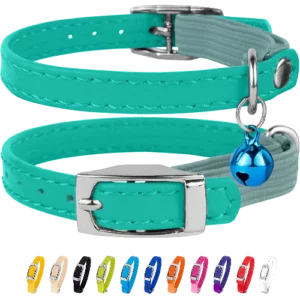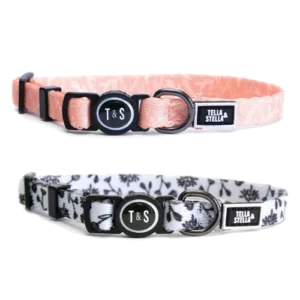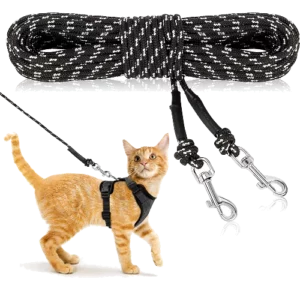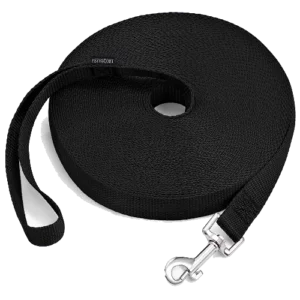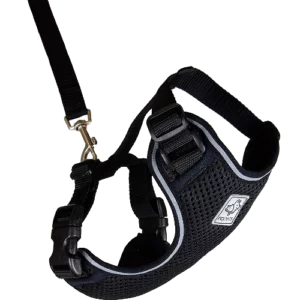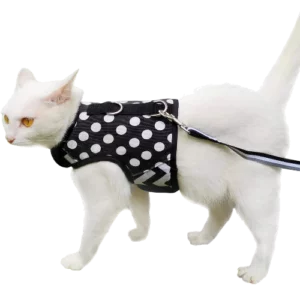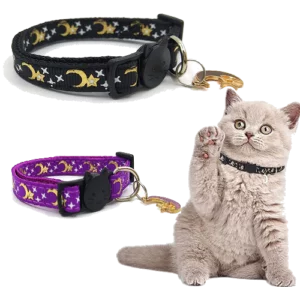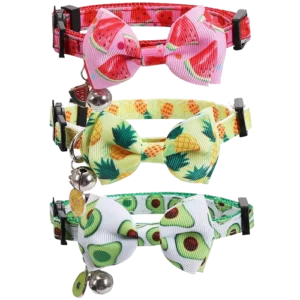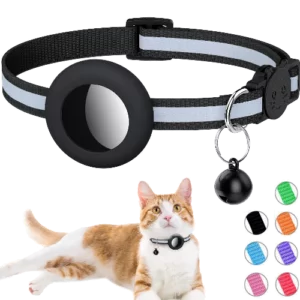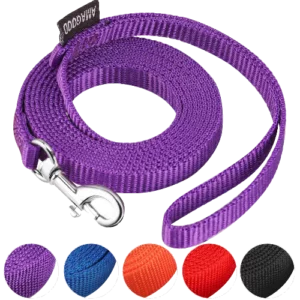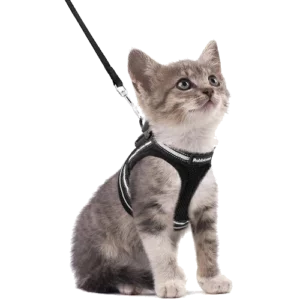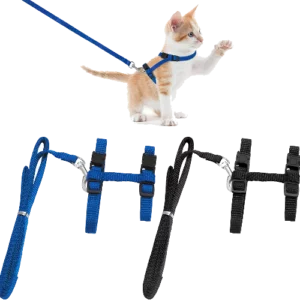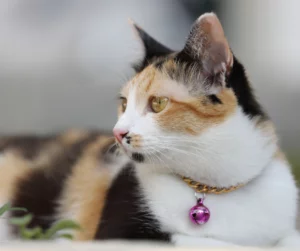
Best Cat Collars, Leashes, And Harnesses in Canada
When it comes to cats, they are sometimes overlooked in the collars, leashes, and harnesses department. Most of the time you don’t think of cats as needing harnesses or leashes, (or sometimes even collars if they are always indoors) but they are a very important part of keeping your feline friends safe and sound.
Whether you want your cat to be safer while outside on a balcony or in the yard, harnesses and leashes are a great idea. You might even like taking your cat for a walk or traveling with you on small adventures! Collars are also very important in case they ever escape, or something happens – then they have their ID and can be easier to spot.
In our list below, we’ve helped narrow down the overwhelming array of top-rated cat collars, leashes, and harnesses that are available to better help you decide what works best for you and your cat, whether they’re a brand new cat addition to your family, or if you’re just looking for something new.
Our Top Picks
How to choose a cat collar, harness, and/or leash
When it comes to choosing new and proper collars, harnesses, and leashes for your cats, keep these different factors in mind:
Collars
Material – Most pet collars are made from nylon, polyester, and cotton blends as it’s durable and easy to keep clean, while being comfortable for your pets. Some cats may not like certain fabric collars though and prefer smoother material such as leather or even rubber.
It’s worth trying out a few different types if you find that your cat is not getting used to their collar and always scratching or trying to get it off. Some may not ever like any collar, but it is worth trying your options first.
Size – Size is very important, especially if you have a kitten or younger cat that grows very quickly. A rule of thumb for all pet collars is that it should be snug enough that you can fit your fingers underneath the collar without it being too loose. If you can’t, then the collar is too tight.
Be sure to measure your cat’s neck or go by their weight size and make your best guess. Pet collars are adjustable and if you’re in the ballpark for measurements, it should be a good fit. (Until they need a new one)
Durability – Small cats, especially kittens, will chew and play with anything they can get their mittens on. Which also includes collars and leashes. If for any reason they’ve popped their collar off, it’s important that the material doesn’t fray or break apart easily and present any sort of choking hazard. Most pet collars are made well, but there are always cheaper options that may not be the best in the durability category.
Always read reviews and be sure that they match up for what you need.
Easy-release or buckles – Quick release or break away collars are recommended for cats (and most pets) as the collar will ‘break away’ if it ever gets stuck or caught on something, allowing your pet to be safe and not potentially in danger. Other collars such as leather typically have a buckle or snap to keep them in place, and these should be used cautiously and/or with cats that are typically very calm that don’t tend to get into trouble. Older cats and calm demeanours are perfect for these kinds of collars.
Accessories (i.e. – bows, bells, etc.) – Some cats may not be bothered at all by any added bells or whistles attached to their collars. Others may think that it’s always play time and try their best to wrestle out of their collars.
Safety is also another factor as some fabrics or add-ons can get caught on things around the home. Bows, bowties, larger bells, and even small decorations such as rhinestones can cause troubles if not monitored at first to ensure that your cat won’t destroy their collar or eat any small parts.
Harnesses
Material – Harnesses typically come in similar materials, such as nylon, cotton blends, and polyester. Your cat may have preferences as to what they consider comfortable. Some material may also be more breathable than others and it’s important to keep in mind the weather and humidity as well.
If you happen to be out in the rain or it’s a warmer day, breathability and water-resistance are good material benefits to investigate.
Size – It goes without saying that size is important, especially around their waist and neck. As long as a cat can get their head through something – they can typically squeeze through, as they have floating collarbones. (The joke that cats are liquid is not far off for how easily they can fit through small spaces)
Most importantly is that the neck portion of the harness (regardless of style) is snug but not too tight. If you can fit a finger or two snuggly underneath, you should be good to go. The other area is around their waist. Snug but not too tight or too loose.
Style – There are three styles of cat harness available. The H-harness, the popular vest version, and a more encompassing jacket style.
- H-harnesses are simply straps that have adjustable sections around the neck and waist. They allow the most movement for your cat, and some prefer it since there is less material touching them. It does however allow them to escape much easier.
- Vest styles are the most popular currently and are much safer. Certain cats may take some time before you can get their head through the top section, but most can be coaxed with treats and patience. They distribute the weight easier when your cat may be pulling a lot on their leash and are harder for your cat to squirm out of.
- Jacket styles are used less, but they are easier to put on and are the most durable/protective. You typically just put your cats two front legs through the holes and then wrap the harness around their back with velcro closures. These types of harnesses are great for escape artists and cats that don’t enjoy the other types.
Durability – Durability is important, especially if you’re taking your cat out for walks or travels regularly. Breathability and water resistance are important, especially on hotter days.
Leashes
Material – Materials for leashes are like everything else on this list. Nylon, cotton/polyester blends, and leather are the most popular. Water-resistance and durability and typically most important.
Durability – A durable leash is great for longer walks and to make sure that it won’t break if your cat pulls, chews or scratches on it while out or even while getting used to it before you use it.
Length – Leashes for cats can be very long or short, depending on where they’ll be wandering around. If you’re going on walks, you can have short clips with carrier backpacks to ensure they don’t jump out. Medium lengths can be great for walks around the neighbourhood and for keeping your cat safe while on a balcony or in the background. Long leashes are great for allowing your cat the freedom to roam (where it’s safe of course) such as camping or on property with large yards, etc.
CollarDirect Leather
This beautiful leather collar is a great choice for cats that seem to itch and overall dislike other collars/materials. It’s made from genuine leather, has a metal buckle, and an elastic inner band that will stretch if your cat gets caught on something, as an included safety feature.
One of the main review complaints is that the smaller size can run a bit too snug, so you may want to size up if you’re unsure. All sizes are adjustable. They also make matching leather leashes to go along with these collars.
Each collar does come with a small bell, not loud enough to be annoying, but enough that you’ll know where your cat is when they’re running around. Reviews say that they are durable and work very well for cats that were tearing out their fur with other fabrics. If you have a sensitive cat, these are worth a try.
Pros
- Multiple colours.
- Good for allergy prone cats.
- Safety stretch material inside.
Cons
- Can run a bit small.
Tella & Stella Collar
These Tella & Stella cat collars are very highly rated and are a Canadian company! If you’re wanting to shop local, these are for you. The fabric is very soft and durable and is reviewed/rated to be great for cats that have allergies or are uncomfortable from other types of collars.
They close with a buckle and are designed to breakaway if your cat ever gets caught on something. The collar itself is sturdy and the D-ring to attach a small bell and/or tags have double-stitching for durability. They’re also fully adjustable from 7-inches to 12-inches. This brand does have all manner of collars for pets, so if you need a different size, they most likely carry it as well.
Pros
- Safe breakaway style.
- Multiple colours.
- Comes in packs of 2.
- Very durable.
Cons
- May not be suited for very small kittens.
2-Pack Breakaway collars
If you have multiple cats or kittens and need two collars, or if you want to just change up the style every once in awhile – this two pack of durable nylon breakaway collars are an inexpensive and good choice to try.
The cute moons and stars pattern have small sections that glow in the dark. They’re both adjustable from 8-inches to 12-inches, and the clasp is easy to put on and take off, including the breakaway snap if your pet ever gets caught on something or snagged.
Nylon blend material is soft and comfortable on most cats skin and fur, though some may be sensitive to this type of material so be sure to check if they’re scratching too much or are trying to take it off very often.
Pros
- Nylon material.
- Adjustable.
- Breakaway style.
- Great for kittens.
Cons
- Not a good fit for larger cats.
Bowtie 3-pack
This 3-pack of adorable cat collars with bowties and cute fruit designs is a wonderful addition if you’re looking to ‘dress up’ your cats collar style. Whether it’s for an event or just hanging around at home, these collars are a great deal if you want to brighten up your day.
They do come with a small bell and fruit shaped charm, but they can be taken off if you’d like/want to be safer. The bow is a decent size, not so large that it gets in the way but not so small that it can’t be seen. Material wise this is a nylon ribbon type, that can be chewed or otherwise destroyed if your cat gets a hold of them to play with.
Pros
- Breakaway style buckle.
- Cute designs.
- Adjustable.
Cons
- Rambunctious cats/kittens may be able to chew through these.
Airtag holder collar
If you have an Apple airtag for your household belongings and want to get one for your pet to ensure that they’re not in any trouble – this inexpensive airtag holder collar is a helpful way to keep track of your pet around the home or if they tend to run outside the window or yard.
This collar has adjustable sizes from 7.87″ to 13″. 3/8″ exactly, and it does have a small bit of stretch. The company does have a lifetime guarantee refund if you’re unhappy with these collars, so you can be assured of a refund if you/your cat decides that they don’t like it.
Pros
- Breakaway style buckle.
- Reflective strip.
- Adjustable.
- Secure airtag holder.
Cons
- Some cats may dislike the material/airtag holder.
- Durability can be hit or miss.
Rypet reflective leash
This two-hook style 15-foot leash is great for attaching to cat harnesses (and works well for other smaller pets) It has a reflective strip intertwined throughout that helps keep you and your pet safe while you’re walking, especially at night.
It is made from lightweight braided nylon material that is durable and resists fraying/breaking. It can be chewed however if you have rambunctious cats or pets, so that is something to keep in mind. This particular leash is perfect for allowing your cat to roam in the yard, while camping, hiking, or even having them be safer while on an apartment balcony.
Pros
- Reflective.
- Durable.
- 360-degree swivel hooks.
Cons
- Two hook design.
- Strong/mischievous cats can break the lead.
Amagood 6-ft leash
These 6-foot leashes all have different widths and lengths to suit your needs and pet size! This smaller leash is a great size for most cats (and small dogs) without being too restrictive or long. It’s a lightweight nylon material that wicks away water and keeps the leash free from mold or rusting on the nickel-plated accessories.
The reinforced stitching should hold up against most pets, though a rambunctious cat that loves chewing or breaking things could potentially still destroy it, so always be sure to keep an eye on it with your pet.
Pros
- Multiple widths and lengths.
- Lightweight.
- Water resistant.
Cons
- Some cats may be able to break it.
Longline lead leash
If you’re wanting to get a very long lead for your cat to run around the yard safely or out in a field, on the beach, while hiking, etc. – this long leash that comes in lengths from 15ft to 50ft can be a perfect fit for that!
Lightweight, single loop for holding, reinforced stitching, and nickel-plated 360-degree swivel make it a sturdy regular leash for taking your cat for walks without any worries of it breaking or getting snagged. Be sure to use this length of leash in as open of an area as you can, to prevent any tangling or your cat getting caught up in the lead.
Pros
- Multiple size choices.
- Multiple colours.
- Lightweight.
Cons
- Durability can be a toss-up.
Rabbitgoo Harness and leash
Rabbitgoo is a well trusted brand when it comes to pet accessories, and for good reason! This harness (and included leash) are a perfect starting point if you’re looking to get a safe and reliable harness for your cat to get used to for walks or being safe in the yard, on a balcony, etc.
It comes with a fast release buckle and reflective strips sewn in for safety, and the harness has a back buckle and ‘magic tape block’ to ensure a proper fit that they can’t wiggle out of. It’s made from soft mesh and fabric that allows for breathability and the step-in factor makes this super easy to get on and off your cat.
It does have an adjustable strap and the vest style protects your cat from being pulled by their neck like with a collar and leash. As with all harnesses, be sure to measure your cats neck and waist area to ensure that you get a good fit that isn’t too loose or too tight.
Pros
- Multiple colours.
- Comes with leash.
- Dependable brand.
Cons
- Not a good fit for very large cats.
RC Pets harness
RCPets is another good and reliable pet brand. The neck and waist are fully adjustable and they are sturdy. The soft fabric mesh allows for breathability and a reflective strip along the edges of the harness help with safety at night or evenings.
This harness is the type that requires your cat to put their head through the front loop, which may take some patience depending on your pet. It comes in small, medium, and large sizes – be sure to measure your cat before choosing a size, especially since the collar portion is adjustable, but you still need to be able to fit their head through and snuggly have it against their waist.
Pros
- Durable.
- Adjustable.
- Multiple sizes.
Cons
- Some cats don’t like the head-through style.
Miwi 2-pc harness
Sometimes simple is best and when you’re getting new kittens or cats into wearing a harness, you can’t go wrong with basic strap harnesses. This listing comes with two, so if you have more than one cat, a new kitten, or you just like having an extra around – this is a great one to check out and give a try.
They’re adjustable and have easy on/off buckles that you just need to clip around your cats neck and waist after you stepped their legs through the proper areas. The straps go around your cats neck and chest, as there is a little belt design. It takes pressure off of their neck, allowing for safer use.
Pros
- Simple.
- Easy to use.
- Adjustable.
Cons
- Durability could be better.
- Not for very large cats.
Cat jacket style harness
Jacket style cat harnesses are perfect for cats that tend to escape or wiggle out of anything. They’re also the safest and tend to be easier to put on, as you put your cats legs through the holes and then wrap them up with the velcro closure around their back. They fit snug and tend to be very durable.
This one is lightweight and comes with a magic tape closure, no buckles, but the tape is very secure. Make sure to measure your pet well for these kinds of harnesses as they are definitely less forgiving when it comes to adjustments.
Be sure to practice with your cat before taking them outside, as these jacket styles are a bit more hindering so your car may just plop over the first while before they get used to it. It’s recommended to have your cat wear it for around 20-30mins a day indoors before they get used to it and doesn’t bother them to wander around.
Pros
- Durable.
- Safest design.
- Adjustable.
Cons
- May take some time for your cat to get used to it.
Our methodology
For this article, we used the top-rated reviews from owners across Amazon, the web, and other trusted review websites that specialize in pet products. We also considered our own personal use with these products with our own pets. We took into account budgets, styles, and pet sizes as well, to ensure that there is a range that will fit most pets and owner’s lifestyles.
Questions and answers on leashes, collars, and harnesses for cats
Is it ok to harness a cat?
Absolutely! Of course, it depends entirely on your cat – some will never, ever get used to a harness, and sometimes won’t even allow a collar, but with patience, training (and a lot of treats) most cats can become accustomed to a harness and be taken outside for walks or as a safety while in the backyard or on a balcony.
The key is to be patient and to not stress out your cat (or yourself) in the process. Some may just never get used to a harness regardless of how much positive reinforcement you give them and that’s okay too. Overall though, yes a harness is incredibly safe for cats.
How to put on a cat harness?
Some cats require different methods for getting into their harness, but all require patience. (Unless your cat has no problems with wearing collars, leashes, and things in general)
The easiest way to put on your cat harness will depend on what kind of harness you have. Most are made so that you have to put their front legs through and then get their head through the neck loop section. Some you just put their legs through the holes and the top of the harness wraps around with velcro and a clip.
Some cats may need to be coaxed through with a treat, some may be fine to just slip into their harness no problem. The key is to be patient and not make the process stressful, otherwise your cat may never warm up to it. You can also encourage them with cat toys and other distractions while they’re getting used to it.
How to leash train a cat?
Leash training a cat is similar to getting them used to a harness, but is typically easier in that you generally would clip a leash to their harness as that’s much safer than attaching it to just a collar.
Go slow and give them time to walk around with the leash attached first, giving them slack and only pulling slightly when they’re going too far/when they reach the end of their lead. Cats should not be tugged or pulled back while on a leash.
What are the best types of harnesses for cats?
The best types of harnesses for cats varies on how well your cat reacts to certain designs, though most come in two to three variations –
- The simple H-harness that can be adjusted around your kitty’s waist and neck. These are simple straps that allow the most movement and freedom for your cat, and up until the last few years – these were most likely the only ones you could see available in stores.
- Vest style harnesses are arguably the most popular as of now and for good reason. They allow for wide movement ranges still, while keeping your cat safer and snugger while being out and about. It’s perfect for cats that easily squirm out of H-harnesses, and also advised for cats that tend to pull more on a leash.
It keeps them safer and doesn’t pull on their neck, as the harness encompasses their entire chest and body area compared to a point around their neck and waist only.
- Jacket style harnesses are used less than the other two types on the list but are worth noting, as they are generally easier to put on and off, and they keep your cat even safer. They cover far more area of your, and some might actually prefer it.
They come in various colours and they typically have a velcro closure as opposed to snaps and buckles. These styles tend to work where you put their front legs into the holes and then just wrap the fabric around the top of your cat. If your cat is sensitive to noise, they may need to get used to the velcro ripping sound when you open/close the harness.
The best of these really depends on your cat and how much security they might need/how often they try to get away. If your cat is more prone to breaking out of things, opt for the more secure ‘collar’ style one where you must put their head through the top section, or a jacket-style harness. Pet behaviourists also recommend the jacket style when available for cats.
Do cats like collars with bells?
It truly depends on the cat and their personality! Speaking for myself, one of my cats doesn’t mind her collar with a bell at all and it’s great for me because I can always hear her whenever she’s getting into trouble. My other cat can’t stand any collars at all, even after trying different materials.
The best thing you can do is try one out and see how your cat or kitten reacts to it! Most don’t mind and it does give peace of mind when it comes to knowing where your cat is, when they’re jumping up on a counter, or other such things.
Travel harness vs travel bag: What’s best for cats?
Carriers and travel bags are generally the best for cats when they’re travelling, whether it’s by car or (especially) by plane. Some cats can have extreme anxiety while being in a carrier and if you are in a car for example – if you have them set up safely with a travel harness and leash with the option to rest in their carrier, that can work best as well.
For the most part though – whenever possible, travelling with your cats in a carrier will keep them the safest throughout the whole process, with the least amount of stress on them and for yourself.
Read more

The Best Dog Collars, Harnesses, Leashes/Leads in Canada
Here’s everything you need to know to keep your pup safe when going for a walk.
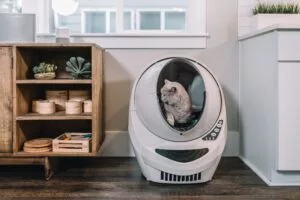
The Best Cat Litter Boxes in Canada
A good cat litter box can go a long way.
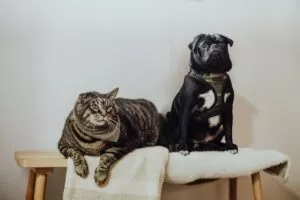
Best Heating Pad for Dogs and Cats in Canada
These pet pads will provide warmth no matter the weather.
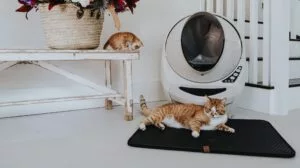
The Best Cat Litter Mats
Keep your home clean without the mess of having cat litter everywhere.
